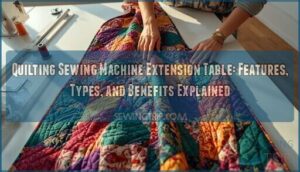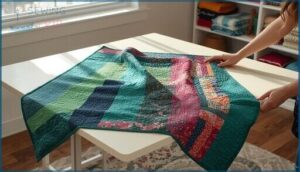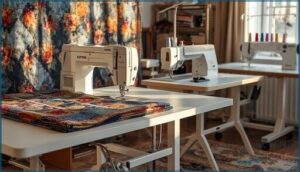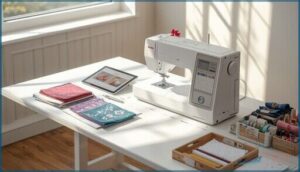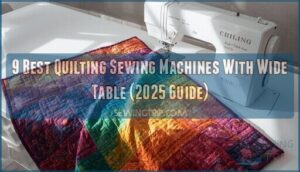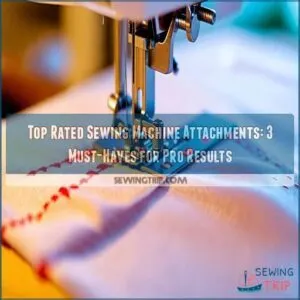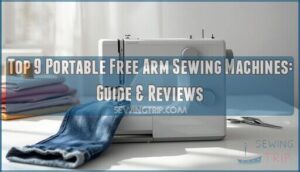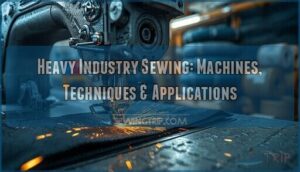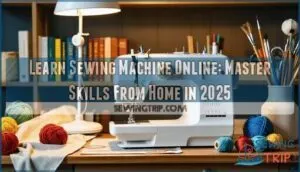This site is supported by our readers. We may earn a commission, at no cost to you, if you purchase through links.
Every seasoned quilter knows the feeling—a vibrant patchwork growing beneath your hands, only for it to tumble and cave at the edge of your machine. Suddenly, precision turns into a juggling act, and those clean lines you pictured start to waver.
That’s where a quilting sewing machine extension table earns its stripes. By turning a cramped space into a generous, steady platform, this tool gives your fabric freedom to move and your hands freedom to create. The humble extension table isn’t just extra real estate—it’s the difference between wrestling your quilt and guiding it with confidence.
Table Of Contents
Key Takeaways
- Extension tables transform cramped sewing spaces into stable platforms that reduce fabric drag and improve seam accuracy, especially for large quilts and free-motion work.
- These tables come in three main types—quilting, embroidery, and overlock—with options ranging from model-specific fits for maximum stability to universal designs for broader compatibility.
- Key features like integrated rulers, adjustable legs, and smooth surfaces directly impact your comfort and precision, making it easier to handle bulky projects without strain.
- Prices span from basic $119 acrylic models to premium $860+ options, with most tables offering free shipping over $49 and warranties ranging from one to five years.
What is a Quilting Sewing Machine Extension Table?
A quilting sewing machine extension table is a tool that gives you more space and better control when working on your bigger projects. It’s built to fit your machine and help everything move smoothly as you sew.
Here’s what you can expect from these handy tables.
Definition and Core Purpose
A quilting sewing machine extension table is your go-to solution for creating a generous Table Workspace. Designed for Fabric Support, it attaches around your machine, making big quilting projects much more manageable.
These tables are designed to offer optimal machine performance. By minimizing needle deflection and improving seam consistency, this essential tool promotes Quilting Accuracy and smoother fabric handling in quilting—giving you the stability needed for the best possible results.
How Extension Tables Enhance Quilting
Once you attach an extension table, you’ll notice an immediate Fabric Drag Reduction—your larger quilting projects glide instead of tugging. This upgrade means less strain and a true Seam Accuracy Boost, especially when free-motion quilting.
You’ll gain Workspace Clutter Reduction and Project Size Management, plus a welcome Posture Comfort Improvement. A compatible table provides extra stability and support for larger projects.
Simply put, quilting extension tables make fabric handling in quilting smoother and your time more productive.
Key Features and Construction Materials
That smooth, level surface you notice is no accident—quilting extension tables blend sturdy plastic construction, thoughtful acrylic thickness, and handy features like integrated rulers. Adjustable legs let you fine-tune height, so your workspace feels just right.
A polished surface finish helps fabric glide, while strong frame stability bolsters large projects. Each detail keeps your focus where it belongs: sewing your best work.
Essential Benefits for Quilters
Quilting often calls for more space and support than a sewing machine alone can offer. An extension table brings practical solutions that make tough projects feel manageable.
Here’s what makes it a must-have for any serious quilter.
Supporting Large and Bulky Projects
Ever tried wrangling a queen-size quilt on a standard sewing bed? Extension tables are your best teammate for supporting large projects, spreading the fabric weight across a broad, steady surface.
Extension tables are the key to handling huge quilts, giving every project the steady support a standard sewing bed can’t provide
This weight distribution cuts drag, improves free-motion support, and lessens shoulder strain. With workspace integration, you’ll notice how bulky quilts move easily, letting you focus on the creative flow.
Improving Fabric Handling and Seam Accuracy
Getting fabric to flow smoothly without bunching or slipping takes more than luck. With an extension table, fabric drag reduction and increased surface stability give you finer control.
Seam allowance accuracy improves noticeably, while ergonomic advantages help you maintain focus. That means boosted quilting precision, fewer misalignments, and a real difference in finished quilting quality—especially when handling intricate seams or delicate materials.
Increasing Comfort and Workspace Control
When your sewing workspace expands with an extension table, ergonomic posture becomes second nature. You gain steady fabric support and keep your arms relaxed, so those prolonged sessions don’t take a toll.
Clear visual access to the needle area and a smart workspace layout let you quilt with control and comfort—a true game changer for quilting precision and sewing comfort.
Types and Compatibility Options
There’s more than one way to expand your sewing surface and upgrade your setup. Each extension table type brings its own strengths and works best with certain machines.
Here’s what you’ll find when exploring your options.
Quilting, Embroidery, and Overlock Extension Tables
Need more support when working on your biggest projects? Extension Table Products come in three main types: Quilting Tables for large quilt tops, Embroidery Tables with hoop clearance, and Overlock Tables for serging edges.
Features you’ll notice include:
- Stability features to curb vibration reduction
- Thoughtful table ergonomics
- Durable surface material
- Smart model compatibility
- Useful sewing accessories
Sizing and Fit for Different Sewing Machines
Choosing the right extension table is a game of precision—just like quilting itself. Machine model fit can make or break your results.
Brand size guides and careful measuring of your machine’s free arm guarantee a smooth workspace. Universal table limits exist, and mismatches impact seam accuracy.
Every sewing machine model calls for its own thoughtful fit, supporting quilters’ best work.
Model-Specific Vs. Universal Extension Tables
Ever wonder what truly sets a model-specific quilting extension table apart from a universal one? It’s a balancing act between fit precision and compatibility risks.
Model-specific sewing machine extension tables grip your machine for sturdy, unified results. Universal tables widen the fit but may sacrifice stability factors.
Cost comparison often favors universal options, but user preferences lean on accurate machine models.
How to Choose The Right Extension Table
In choosing an extension table, a few key details can make all the difference in your sewing space. Understanding what to look for helps you find just the right fit for your needs.
Here’s what you’ll want to keep in mind as you explore your options.
Assessing Table Size and Material Quality
Wondering if your workspace acts more like an ally or a stumbling block? The right quilting extension table ups your game, with size and material shaping every stitch. A larger, smooth surface cuts down on fabric drag, boosts ergonomic height, and lets material flow freely.
Check this table for quick insight:
| Feature | Why It Matters |
|---|---|
| Table Size Impact | Accommodates bulky quilts, less shifting |
| Material Durability | Withstands wear, lasts longer |
| Ergonomic Height | Prevents slouching, eases strain |
| Weight Considerations | Easy to move or sturdy stability |
| Surface Smoothness | Glides fabric, perfect seam accuracy |
Matching Extension Tables to Your Machine Model
You’ve got the right table size—now check fit accuracy. Since most extension tables are matched to specific sewing machine models, model verification keeps stability issues at bay. Even a slight mismatch can make quilting feel wobbly.
Many quilters turn to custom solutions for a guaranteed match. For stress-free installation, follow the brand’s installation tips made for your quilting table.
Features to Consider (Rulers, Adjustable Legs, Accessories)
Model-to-model fit isn’t the end—real quilting mastery comes from the smart features beneath your fingertips. Look for these when weighing options:
- Integrated Rulers for precision
- Adjustable Height with sturdy legs
- Storage Options like trays or magnetic strips
- Cutout Designs for ruler work or stitch regulation
- Accessory Kits designed for general sewing machines
Each feature streamlines your quilting table experience.
Shopping, Pricing, and Customer Experience
When you’re selecting a quilting extension table, there’s a lot to think about beyond just fit and function. It helps to know what to expect with pricing, product choices, and how the shopping process works.
Here’s what you’ll want to keep in mind as you look at your options.
Price Ranges and Product Options
You’ll find entry-level tables start around $119, often made from smooth acrylic for basic quilting tasks. Mid-range features like rulers or extra support boost prices into the $159–$289 zone. Premium materials, universal options, and model-specific fits can reach $860 or more.
Sales trends show combos and larger surfaces popular. Sewing Machines Plus offers a great price on nearly every product.
Online Shopping and Shipping Policies
Online shopping for extension tables goes beyond picking your favorite model or price point. Delivery and shipping matter—most orders over $49 ship free and include tracking insurance. Be mindful: custom tables might take weeks, and opened items rarely qualify for returns.
Online stores often highlight:
- Detailed delivery timeframes
- Shipping costs breakdown
- Product quality and price guarantees
- Clear return eligibility policies
Frequently Asked Questions (FAQs)
Can extension tables be used for embroidery hoops?
Think of a bridge built for heavy traffic—when using embroidery hoops, table stability and module clearance are key.
Some embroidery machines accept sewing machine extension tables, but hoop compatibility and universal adapters depend on your project size and setup.
How do you clean and maintain extension tables?
Daily wiping keeps your extension table’s smooth surface free from lint and dust, while surface polishing every few weeks preserves fabric glide.
Regular bolt tightening, safe storage, and setting ergonomic height all help your sewing machine accessories last longer and perform beautifully.
Are extension tables easy to store and transport?
Foldability features and detachable legs make table extensions a breeze to store. Compact storage dimensions fit sewing room furniture, while quilting tables often slide under beds.
Transport cases earn praise in user reviews, simplifying class trips and sewing room setups.
Do extension tables affect machine vibration or noise?
Extension tables can reduce vibration and noise if built with sturdy materials and good damping, improving your machine quilting experience.
A rigid, well-fitted sewing machine extension table prevents unwanted noise amplification and adds ergonomic benefits to your sewing machine setup.
What warranty or support comes with extension tables?
A stitch in time saves nine, so check warranty duration and claim services before buying sewing machine accessories.
Most extension tables include one to five years of coverage, with customer returns and support access through authorized dealers.
Conclusion
You could try quilting without a quilting sewing machine extension table—and spend half your time wrestling fabric instead of stitching. Or you could claim that extra support, let your quilt glide like it’s meant to, and focus on the craft you love.
The right table doesn’t just expand your workspace; it transforms how you move through every seam. Choose wisely, stitch confidently, and watch your projects unfold exactly as you imagined.
- https://marketintelo.com/report/quilting-machine-market
- https://www.linkedin.com/pulse/us-quilting-machine-market-unveiling-competitive-dynamics-1rwfe
- https://www.datainsightsmarket.com/reports/stationary-longarm-quilting-machine-605532
- https://www.youtube.com/watch?v=BPvi64vjYHE
- https://syn-165-227-127-094.res.spectrum.com/sewing-machine-extension-tables/

